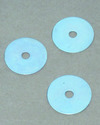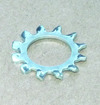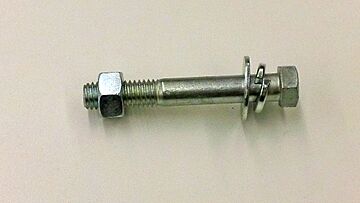Washer (hardware) facts for kids
A washer is a small, flat disc, usually with a hole in the middle. Think of it like a tiny donut made of metal or plastic! Washers are mostly used with bolts and nuts. They help spread out the pressure when you tighten a bolt, which stops the bolt head or nut from damaging the surface it's pressing against.
Washers have other cool uses too! They can act as spacers to create a gap between parts, or as tiny springs to keep things tight. Some washers help prevent parts from wearing down, while others stop vibrations or help lock a bolt in place so it doesn't come loose.
Most washers are made from metal or plastic. For strong connections, especially with steel bolts, you might use a special hardened steel washer. This helps keep the bolt tight and prevents it from digging into the material. Washers can also stop different metals from reacting badly with each other, like preventing a steel screw from corroding an aluminum surface.
The word "washer" has been around for a long time, first recorded in 1346. However, its exact meaning wasn't written down until 1611.
Sometimes, people call rubber or fiber gaskets used in faucets (like in your sink) "washers." While they look similar, gaskets are usually designed to seal against leaks, which is a bit different from what most washers do.
Contents
What Are the Main Types of Washers?
Washers come in three main groups, each with a different job:
- Plain washers: These are simple flat discs. They help spread the weight or pressure from a bolt, protecting the surface underneath. They can also provide insulation, like stopping electricity from flowing.
- Spring washers: These washers are a bit flexible. They push back slightly when tightened, which helps prevent bolts from loosening due to vibrations.
- Locking washers: These are designed to stop a bolt or nut from unscrewing. They often work by creating extra friction or biting into the surface. Many locking washers are also a type of spring washer.
Plain Washers Explained
Plain washers are the most common type. They are flat and usually round, like a ring.
| Name | Image | What it does |
|---|---|---|
| Plain washer (or "flat washer") | This is a flat metal ring. It spreads the pressure from a screw or bolt. It's also useful if the hole you're using is bigger than the nut, helping to cover the gap. | |
| Fender washer (US), penny washer (UK) | This is a flat washer with a very wide outer edge compared to its hole. They are great for spreading pressure over thin materials, like the metal on a car's fender (that's where they get their name!). They can also help fix connections where a hole has become too big from rust or wear. | |
| Spherical washer | This washer has a curved surface. It works with a special nut to help parts connect properly even if they are not perfectly straight or aligned. | |
| Anchor plate or wall washer | This is a large plate or washer connected to a long rod or bolt. You often see them on the outside walls of old brick buildings. They help make the building stronger. Many are made to look decorative too! | |
| Torque washer | Used in woodworking, this washer has a square hole that fits a special bolt. It has teeth that dig into the wood. This stops the bolt from spinning when you tighten the nut. |
Spring and Locking Washers Explained
These washers are designed to keep things tight and prevent loosening.
| Name | Image | What it does |
|---|---|---|
| Belleville washer (conical washer) | This washer has a slight cone shape. When you tighten it, it flattens out and pushes back, creating a strong force. Some have jagged edges for better grip. | |
| Curved disc spring | Similar to a Belleville, but it's only curved in one direction. It provides a lighter spring pressure. | |
| Wave washers | This washer has a "wave" shape. When squeezed, it acts like a spring. Wave washers don't create as much force as Belleville washers. | |
| Split washer or spring lock washer | This is a ring that's cut at one point and bent into a spiral shape. It pushes against the bolt head and the surface, creating friction. This helps stop the bolt from turning and coming loose. | |
| Toothed lock washer (star washer) |
|
This washer has teeth that stick out, either inwards or outwards. These teeth bite into the surface, which helps lock the bolt in place. They work very well on softer materials like aluminum or plastic. |
| Tab washer | This locking washer has a small tab on the side. You can bend this tab against the nut to stop it from turning. | |
| Wedge lock washer | This washer is made of two pieces. Each piece has teeth on one side and a wedge shape where they meet. They create a very strong lock against vibrations. |
Lock washers, special nuts, and special glues are all ways to stop bolts from shaking loose.
Gaskets that Look Like Washers
Sometimes, the word "washer" is used for certain types of gaskets. These are usually used to create a seal.
| Name | Image | What it does |
|---|---|---|
| Shoulder washer | This is a plain washer with a built-in tube. It's used to separate different metals or to create a seal. It can also be used to insulate electrical parts. | |
| Crush washer | Made from soft metals like aluminum or copper. These washers are used to seal connections for liquids or gases, like in car engines or hydraulic systems. When tightened, they "crush" slightly to form a tight seal. |
Special Washers
Here are a few other unique types of washers:
| Name | Image | What it does |
|---|---|---|
| Keps nut or K-lock nut | This is a nut that already has a washer attached to it. This makes it easier to use because you don't have to put the washer on separately. | |
| Self-aligning washer | This washer has two parts that fit together with curved surfaces. It helps a bolt tighten correctly even if the surface isn't perfectly flat or straight. | |
| Top hat washer | A type of shoulder washer used in plumbing, especially for fitting taps. | |
| Insulating shoulder washer | Used to stop electricity from flowing between a screw and the surface it's holding. They are often made of plastic like nylon or Teflon. | |
| Keyed washer | This washer has a special "key" or tab that stops it from spinning. It's used to lock two nuts in place, like on a bicycle's headset. | |
| Torque-limiting washer | This washer is designed to stop you from tightening a bolt too much. It limits the twisting force (torque) to a certain level. | |
| Dowty washer | This washer has a rubber ring in the middle. It creates a very strong seal against high-pressure liquids or gases. |
What Are Washers Made From?
Washers can be made from many different materials, including:
- Metals: Like steel (including stainless steel), copper, brass, aluminium, titanium, and zinc.
- Special Alloys: These are mixtures of metals, such as silicon bronze or Inconel.
- Plastics: Many types of plastics are used, like polyethylene and PTFE (Teflon).
- Nylon: A strong and durable plastic often used for washers.
- Other Materials: Such as fibers, ceramics, rubber, felt, leather, and even mica.
- Phenolic: This material is great for electrical insulation. It's light, tough, resists heat, and doesn't absorb much moisture. Phenolic washers are often used instead of metal ones when you need to stop electricity from flowing.
How Washers Resist Rust
To stop washers from rusting or corroding, several methods are used:
- Metal Coatings: Washers can be coated with metals like zinc, cadmium, or nickel. Zinc acts like a shield, rusting before the washer itself does.
- Electroplating: This involves coating the washer with metals like chromium or silver using electricity.
- Phosphating: This creates a tough, protective layer on the washer, often combined with oil for extra protection.
- Browning or Bluing: This process uses chemicals to create a special colored surface on steel washers that helps prevent rust.
- Chemical Plating: This uses a special nickel-phosphor mix to create a very strong, rust-resistant surface.
How Washers Are Classified
In the United States, the American National Standards Institute (ANSI) has rules for flat washers. "Type A" washers are for general use and don't need to be super precise. "Type B" washers have stricter rules and come in "narrow," "regular," or "wide" sizes for specific bolts.
In the UK, the British Standard (BS4320) uses "forms" from A to G to describe the size and thickness of flat washers.
- Form A: Normal size, normal thickness.
- Form B: Normal size, light thickness.
- Form C: Large size, normal thickness.
- Form D: Large size, light thickness.
- Forms E, F, G: These are for "black" (uncoated) steel washers, often with larger diameters or thicknesses.
Images for kids
See also
 In Spanish: Arandela para niños
In Spanish: Arandela para niños
- Bit guard
- Dowel
- Unified Thread Standard
















